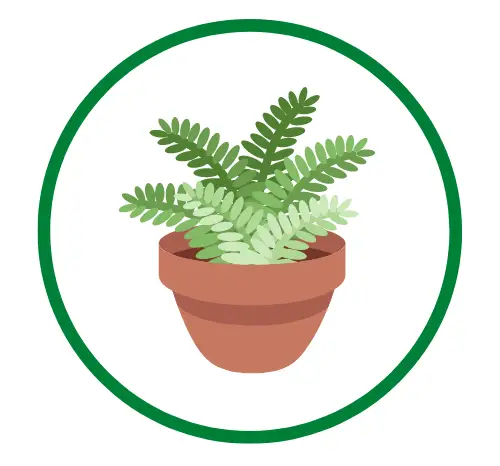What to Do When Your Venus Flytrap Flowers?
Is the Venus flytrap you own in flowers? You want to see Venus fly trap flower bud? You can learn everything there is to know about the Venus fly trap flowering process from this article.
When they are fully grown, Venus fly traps flower each spring. They create flower stalks that develop into bunches of white flowers with green veins. The plant loses energy during flowering so it can concentrate on reproduction.
The Venus fly trap’s flowering process is perfectly normal. However, as a novice grower of Venus flytraps, you must determine whether continuing the flowering cycle is the best course of action. Additionally, you might be interested in seedlings or flower stalks for plant propagation. For more details, continue reading.
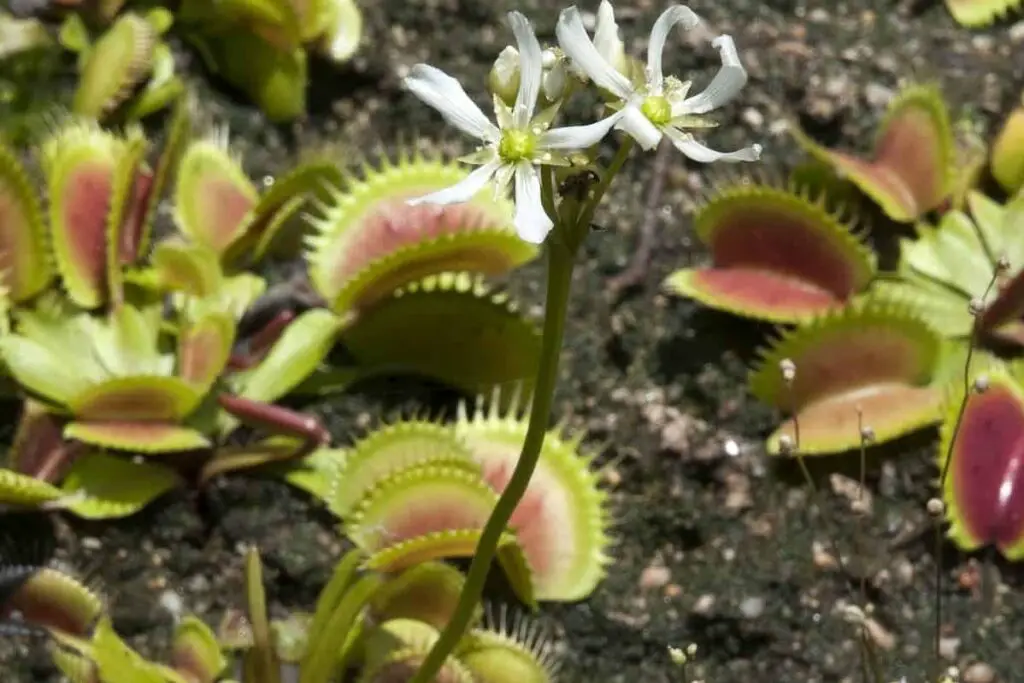
The Venus Flytrap Flowering Process
Why is My Venus Flytrap Growing a Long Stem?
A Venus flytrap will begin to produce flowers once it reaches maturity, which typically occurs between the ages of 2-4. Flowers are produced by Venus fly traps in the spring. Exiting dormancy is typically not too far apart from that.
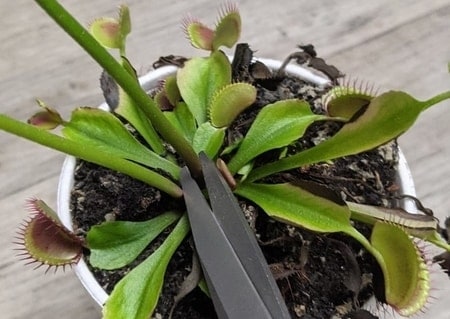
You’ve just noticed that your Venus flytrap is developing a long stem; what could it be? Is this stem necessary for the plant, or should it be immediately cut off? The details provided here can undoubtedly aid you in making decisions if you are unfamiliar with Venus fly traps.
Your Venus flytrap is getting ready to bloom if it has a growing stem or stalk. Because flowering consumes a lot of energy and slows plant growth, you should cut the stalk when it is about 2 inches high.
Flowers stalks are produced by Venus fly traps as thick, cylindrical structures. The flower stalks eventually grow much taller than the traps and form flower bunches. Although not particularly spectacular, the flowers are still attractive. They are white flowers with green veins encircling the petals. It’s unusual to see a Venus flytrap in bloom.
Most people typically only look to spot the traps. When people learn that Venus fly traps can also produce flowers, they are often impressed.
A Venus flytrap will produce several flower stalks when it blooms. not all at once, but rather over the same span of time.
Special Care During Flowering
Some owners of Venus fly traps believe that during the flowering season, they require special attention. There are no extra care recommendations for the time of year when flowers are in bloom. Just keep taking care of your plant the same way you have been. Although the plant may slow down its growth so that it can concentrate on reproduction, it shouldn’t exhibit signs of distress.
Do All Venus Flytraps Have Stems?
Venus fly trap stalks are green in color and its buds will eventually flower. As the growing season progresses the stem will continue to grow until it blooms.
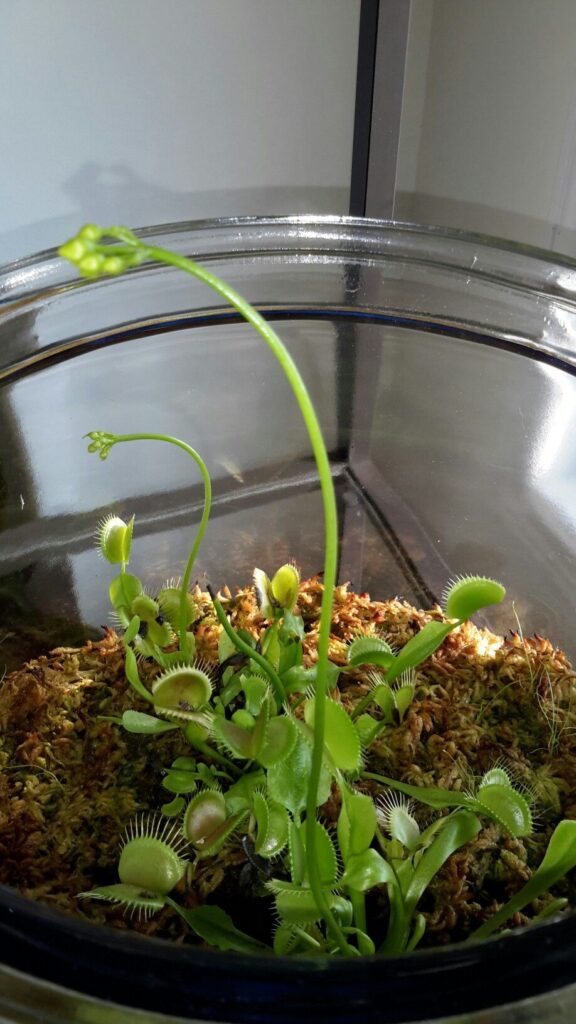
Because they are perennial plants, venus fly traps produce stems. These plants bloom in the northern hemisphere from May to June.
A growing stem or stalk is a sign of health because only healthy Venus flytraps can flower.
Venus fly traps can grow white flowers with five petals. Up to a dozen flowers may be produced by a plant, but this will depend on how healthy it is and the environmental factors.
A Venus flytrap’s readiness to flower can be determined by its appearance in addition to the time of year. Right in the middle of the plant, usually next to a leaf, the stalk will start to grow. The stalk will develop a bud as it grows.
So, in response to the previous question, yes, flower stems will grow on all healthy Venus flytraps. If yours doesn’t, there must be a problem with the plant.
A Venus flytrap that is unable to bloom is deficient in resources because flowering consumes a lot of energy. Lack of food, sunlight, water, and air may be the cause of this. The plant may have root rot or the soil may not be right.If there are issues with the soil, you can apply Jessi Mae Carnivorous Plant Soil Conditioner to improve it.
You still want to see flower stalks even though the majority of Venus flytrap owners do not want their plants to bloom. It is proof that your plant is robust enough to accomplish this.
Remember that these stems only start to appear in May or June. So don’t be concerned if you miss it at any other time. When the stalk eventually appears, you must choose whether to cut it off or keep it. In most cases, cutting it is the solution.
Also read our guide Carnivorous Plants Bog Garden
Should I Cut the Venus Fly trap Flowers Off?
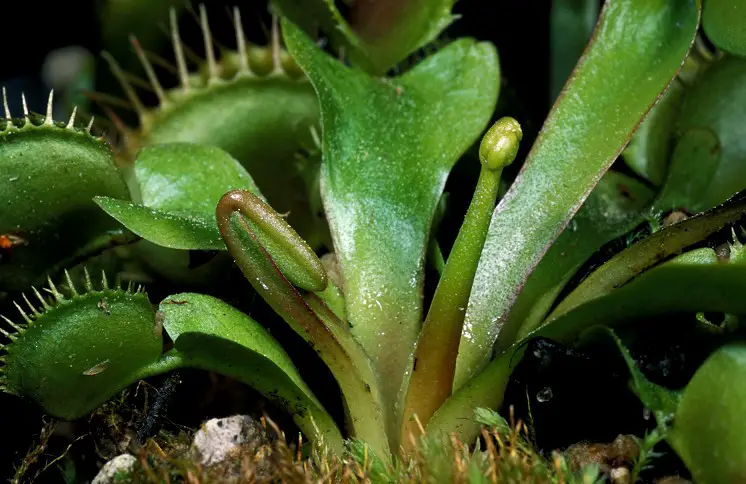
In order to stop your plant from flowering, it is generally advised to remove the flower stalks before they fully develop. I’ll provide some background information in this section to help you decide whether or not to remove the flowers from your Venus fly trap. This decision tree can also assist you in:

Does the Flowering Process Kill Venus Flytrap?
Some inexperienced growers think that Venus fly traps can die during the flowering process. This presumption is incorrect, though.
When a Venus flytrap blooms, it expends a lot of energy concentrating on reproduction. Venus flytraps are not killed or harmed during the flowering process. It merely consumes energy that could be used for other things, like general growth.
There are reasons, as was previously stated, why most people favor to trim the flower stalk. The Venus flytrap’s ability to produce larger traps is constrained by the energy required for flowering. What happens if you opt to keep the flower stalk, though?
If you are an experienced Venus flytrap grower, you can let the stalk develop and bloom. Additionally, if you want to keep the seeds, you should do this. Aside from those, trimming the stalk is the best option.
Your Venus flytrap will experience a lot of stress if the flower stalk is not cut. To heal and continue growing, it will require more nutrients. Venus flytraps are not harmed by having the stalk cut; on the contrary, it benefits them. These plants do not feel pain so cutting the stem is not going to hurt.
Venus flytraps typically reach their growth potential after five years and have a lifespan of at least twenty years. However, doing so uses energy that will be used for flowering.
Venus flytraps require something to trigger its sensors twice before closing because each trap can close approximately five times before it dies. To save energy, this is done. Venus flytraps will lose these energies if you let them flower because they could have been used to make bigger, stronger traps.
After flowering, even a healthy Venus flytrap might not be able to revert to its previous state. You can revive it, but are you prepared to put in several months or even a full year of work for this?
The majority of customers buy Venus flytraps for the traps, not the flowers, in actuality. The best course of action is to get rid of the stalk as soon as you can if you want to see more of these traps.
When to Stop the Flowering Process
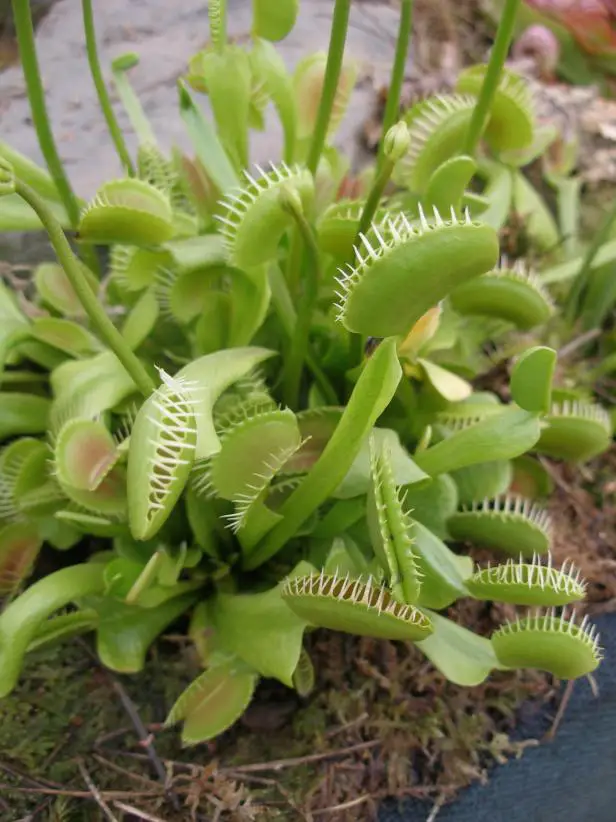
If your plant is fragile, you should remove the flower stalks before flowering is finished. Venus flytraps that are sick or weak might not be able to make it through the entire flowering cycle. For instance, flowering might not be the best course of action if your plant is recovering from a pest infestation or root rot.
Flowers are produced by healthy Venus flytraps in the spring, and they remain healthy throughout the later seasons. If you are certain that your plant is healthy, there is no need to skip the flowering stage. You have already passed the test once you have kept a plant alive for one (or even more than two) years. Many people buy carnivorous plants without doing any research, and they end up killing them within weeks.
Let’s say you are still unsure of your plant’s condition. Review the care considerations after reading this article. It will enable you to determine whether you are caring for your Venus flytrap according to the recommended procedures.
Is It Ever Too Late to Remove the Stalks?
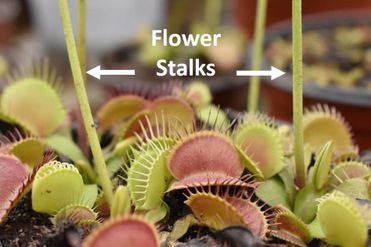
Removing the flower stalks becomes unnecessary at times. Because most of the process is finished and most of the energy designated for reproduction has already been consumed by the plant. It is too late once a flower bud has formed on the flower stalk.
You can still cut it off to stop some of the energy losses associated with flowering. However, it won’t really change much. Alternately, you could simply allow the buds to bloom so you can admire and photograph your plant’s flowers.
How to Cut the Venus Fly trap Flowers Off
Do you believe stopping the flowering process is necessary? If the answer is yes, then continue reading to learn how to remove the flowers.
The sooner the flower stalks are taken out, the better. Don’t hold off until they become tall. Cut them off as soon as you can in its place. The shape of the flower stalks within the plant makes identification simple.
Once the flower stalk has been located, cut it off from the bottom using a pair of scissors. As much of the stem as you can cut off without damaging the center bulb’s surrounding leaves. After that, either discard the flower stalks or try to spread your plant using stalk propagation.
For more details on flower stalk propagation, continue reading!
Throughout the season, Venus flytraps produce numerous flower stalks. For a few weeks, watch your plant closely. Perhaps a few fresh flower stalks will begin spurring.
What to Do With Venus Flytrap Flowers
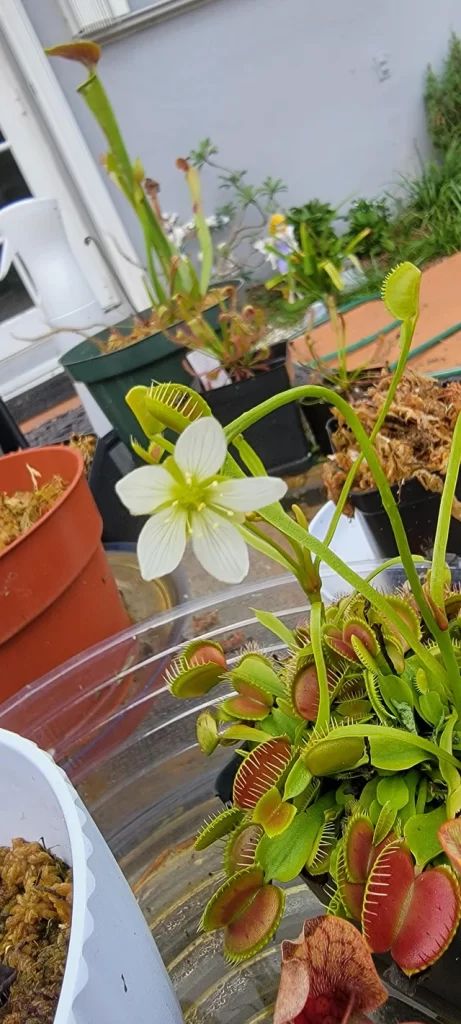
A Venus flytrap flower is fascinating to see for the first time. However, you have the option to propagate your plant in addition to simply admiring the flowers. You can increase your Venus flytrap population by using the methods listed below with very little effort.
Also read our guide 7 Easy Carnivorous Plants – Best Review
Harvest Flytrap Seeds
Even if you only have one Venus flytrap plant, you can still collect the seeds. Pollinators are essential to seed production in the wild. You will perform the role of a pollinator to collect seeds from your plant.
Pollination Instruction
- Allow the Venus fly trap to bloom. The more bouquets of flowers, the better.
- Gather a pollinator-friendly tool. Q-tips or tiny paintbrushes are suitable.
- Find the anther and stigma on a flower by observing it. The pollen is kept in the anther. Additionally, the pollen germinates on the stigma.
- To move the pollen from the anther to the stigma, use a q-tip or paintbrush.
- Continue with the other flowers after pollinating one. Your chances of success will go up.
- To make sure the pollination was successful, wait a few days.
The fertilized flower will show some changes after pollination. Nothing might occur for the first few days. The flowers will then begin to dry out and die, though. This is typical. Just let it shrivel up. When a flower dries out, it will leave behind capsules containing seeds. And each fertilized flower yields multiple seeds.
It is now time to gather the seeds. Remove the flower’s remnants with care, then crack it open to collect the seeds. Ideally, do it inside. Venus flytraps produce tiny seeds. You risk losing those seeds if there’s a slight breeze. Additionally, some people support the area and keep any seeds from escaping or flying away by using a tiny Ziploc bag.
Self-pollination is the act of a plant using its own pollen to reproduce. Such a strategy will result in high-quality seeds. Cross-pollination, however, typically results in better specimens. Let’s say you have multiple Venus flytraps in your house. Think about pollinating one with the other’s pollen.
The Seeds: Storage and Sowing
You can now begin growing Venus flytrap seedlings since you have the seeds. The procedure is easy:
- Assemble a sizable drainage-equipped container. Get a tray as well to place beneath the container.
- Fill it with soil for carnivorous plants and water (distilled).
- To stop fungus outbreaks, mix in a weak fungicide.
- Plant the seeds in the soil of the carnivorous plants. If you can, spread them apart and scatter them.
- The seeds should be lightly pressed down.
- To keep the area moist, fill the tray to the brim with distilled water.
- Keep the seeds in a humid environment at room temperature with access to sunlight.
- In 6 to 8 weeks after sowing, Venus flytrap seeds begin to sprout.
Moreover, you are not required to plant the seeds right away. You can postpone planting them until next week or next month. Put them under refrigeration, though, if you intend to keep them for a few months.
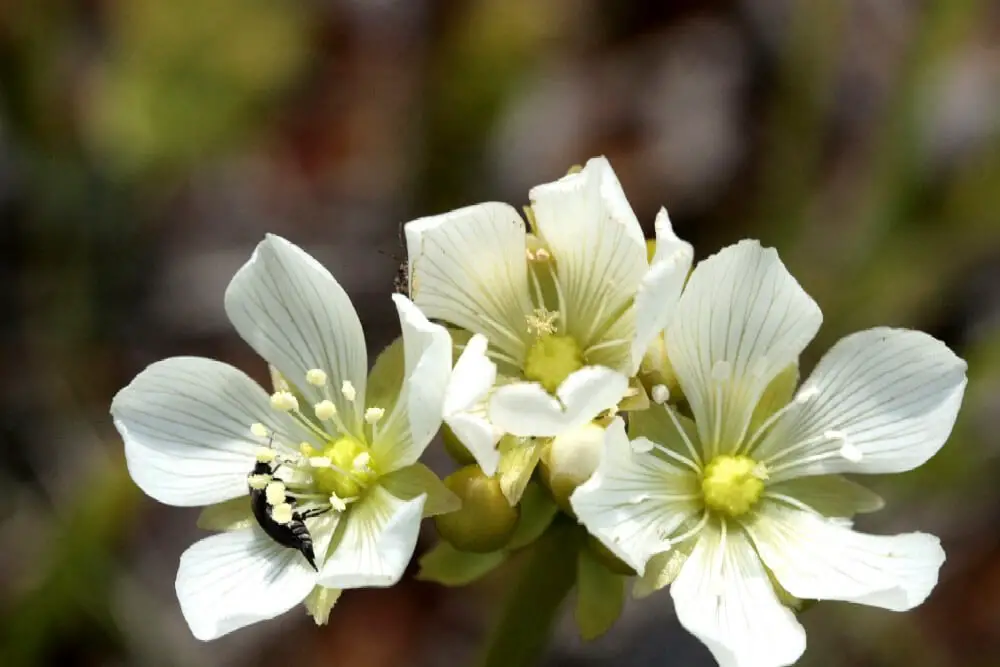
Venus Flytrap Flower Stalk Propagation
Venus flytraps can also be multiplied through stalk propagation in addition to from seeds. Even if the plant hasn’t flowered, you can try this method. However, for flower stalks to successfully reproduce, they must grow.
These are the instructions for Venus flytrap stalk propagation:
- Locate a pot with drainage made of plastic or glazed ceramic. Additionally, gather a plate or tray to place beneath the pot.
- Create some soil for carnivorous plants with the right drainage and aeration. For instance, a popular and successful option is a 2:1 ratio of peat moss and perlite.
- Fill the soil with distilled water until it is completely submerged.
- Put the pot with the moist soil inside.
- Place the pot directly on top of the water plate after adding distilled water to it. This pot will receive bottom-up watering, and a constant humidity level will be maintained.
- Hold off until the stalks have reached a manageable size. You can either wait until the flower buds start to bloom or when they are halfway through their growth.
- The flower stalk should be cut with good scissors. Trim the stems as closely as you can to the bulb. Likewise, remove the flower bud (if applicable)
- Cut the flower stalk into smaller pieces by grabbing it. A 3-inch stalk cutting, for instance, is a suitable size.
- You now have two choices. Place the cutting vertically and stick the remaining portion of the stalk out while burying the remaining half inch underground. Alternately, lay the stalk cuttings flat on the ground and press them against the surface without burying them. After that, spread some soil over the stalk’s ends.
You are prepared. Maintain a humid environment and place the object in direct sunlight. After a few weeks, the cuttings of stalks begin to produce roots. Observe the development and exercise patience.
Interesting Fact About Venus Flytrap Flowers
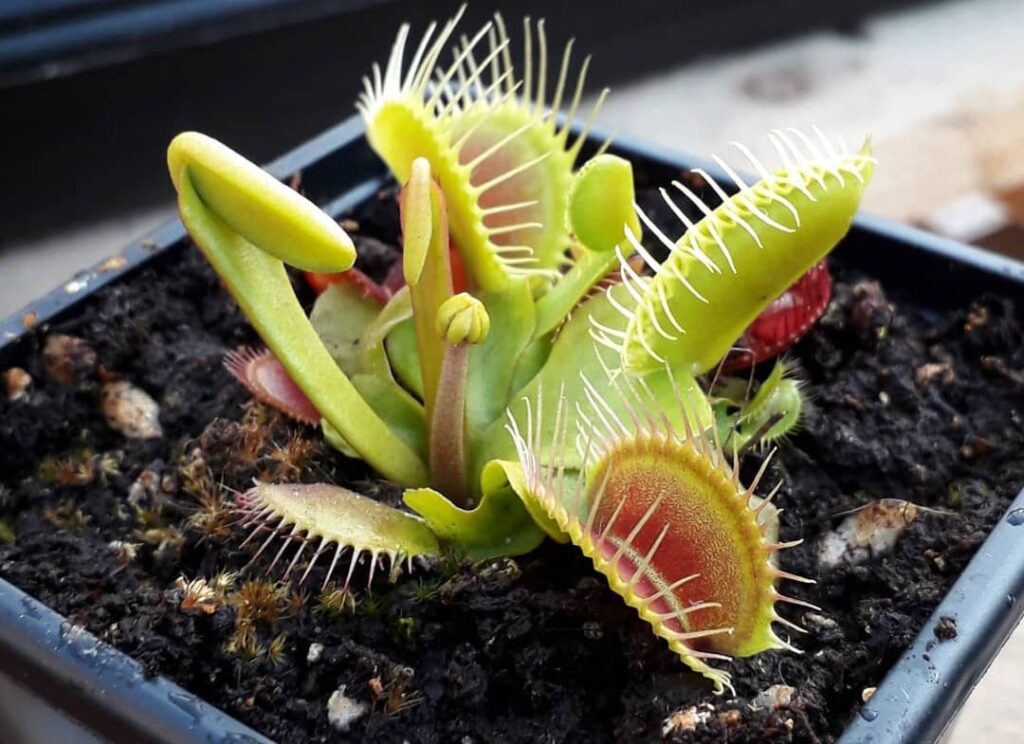
A peculiar plant is the Venus flytrap. One of the most intricate trapping systems ever discovered in the plant kingdom. Additionally, compared to other plant motion, its traps close quickly. But not every adaptation it makes is directed at the leaves or the trapping system. The flowers have also changed to operate as effectively as possible.
Have you ever considered the pollination process for Venus flytrap flowers? Bugs, which are typically the most effective pollinators, are captured and eaten by Venus flytrap. Do they only rely on rain or the wind to pollinate their flowers? The telling justification is as follows:
While a Venus flytrap is flowering, you’ll notice that the traps lengthen to about 4–5 inches, but the flowers tower over the traps by a significant margin. The leaves remain close to the ground while the flowers are perched on top.
To prevent consuming pollinators, the Venus flytrap has evolved to separate its flowers from its leaves. The plant maintains two levels of food and pollinators. Another intriguing Venus flytrap adaptation is this one.
FAQ
How long does it take for a Venus flytrap to flower?
It doesn’t take long for the plants to flower.
Venus flytraps flower during the spring season. The flower grows on a long, cylindrical stalk, giving you enough time to identify and cut the bud.
If you cut it at the right time then you’ll see vigorous growth of the plant during summer.
Should I allow my Venus flytrap to flower?
Fully grown Venus Flytraps flower in Spring, but unless you are an experienced grower and intend to harvest seed, you should cut off the flower stalk once it’s reached about 5 cm tall. Flowering can be exhausting for Venus Flytraps, and most plants will grow more vigorously during summer if prevented from flowering.
What does it mean when my Venus flytrap flowers?
Your Venus Fly Trap will be flowering during a growing season (often through May-June in Northern Hemisphere). If your Venus Fly Trap is healthy and in good condition, it will start growing a long stem that will be often emerging from a center of plant.
Where do you cut Venus Fly Trap flowers?
It into the ground about halfway down. And just do this for the entire flower stalk. And that’s it
How do you tell if Venus fly trap is flowering?
This is why, unless you are a very skilled flytrap grower or have spare plants to risk, I advise you to trim those flower stalks off as soon as you can. You can tell when your plant is going to flower because a weird cylindrical stem (unlike a leaf) will start growing out of the center of your plant.
Should I cut off black Venus flytraps?
People often ask if they should be trimming parts off of their Venus Flytrap, and the answer to this is yes, if it is black.
What happens after Venus flytrap flowers?
Venus flytraps are perennial plants, which means they bloom year after year. The flowers are white with green veins running from the base of the petal toward the edges. Pollinated flowers eventually give rise to seeds. Each trap on the plant can only open and close several times before it dies and falls off.
Should I let my carnivorous plant flower?
Unlike the pitchers, which are deadly to visiting insects, pitcher plant flowers are perfectly harmless. In fact, the flowers function like regular flowers by providing insects (mostly bees) with nectar and pollen.
How long does it take for a Venus Fly Trap to flower?
Venus Fly Trap Life Cycle
Venus fly trap growth rate is slow. They are slow to mature, with plants living as long as 20 years. Although the characteristic carnivorous traps appear soon after germination, plants often take three to four years to flower.
